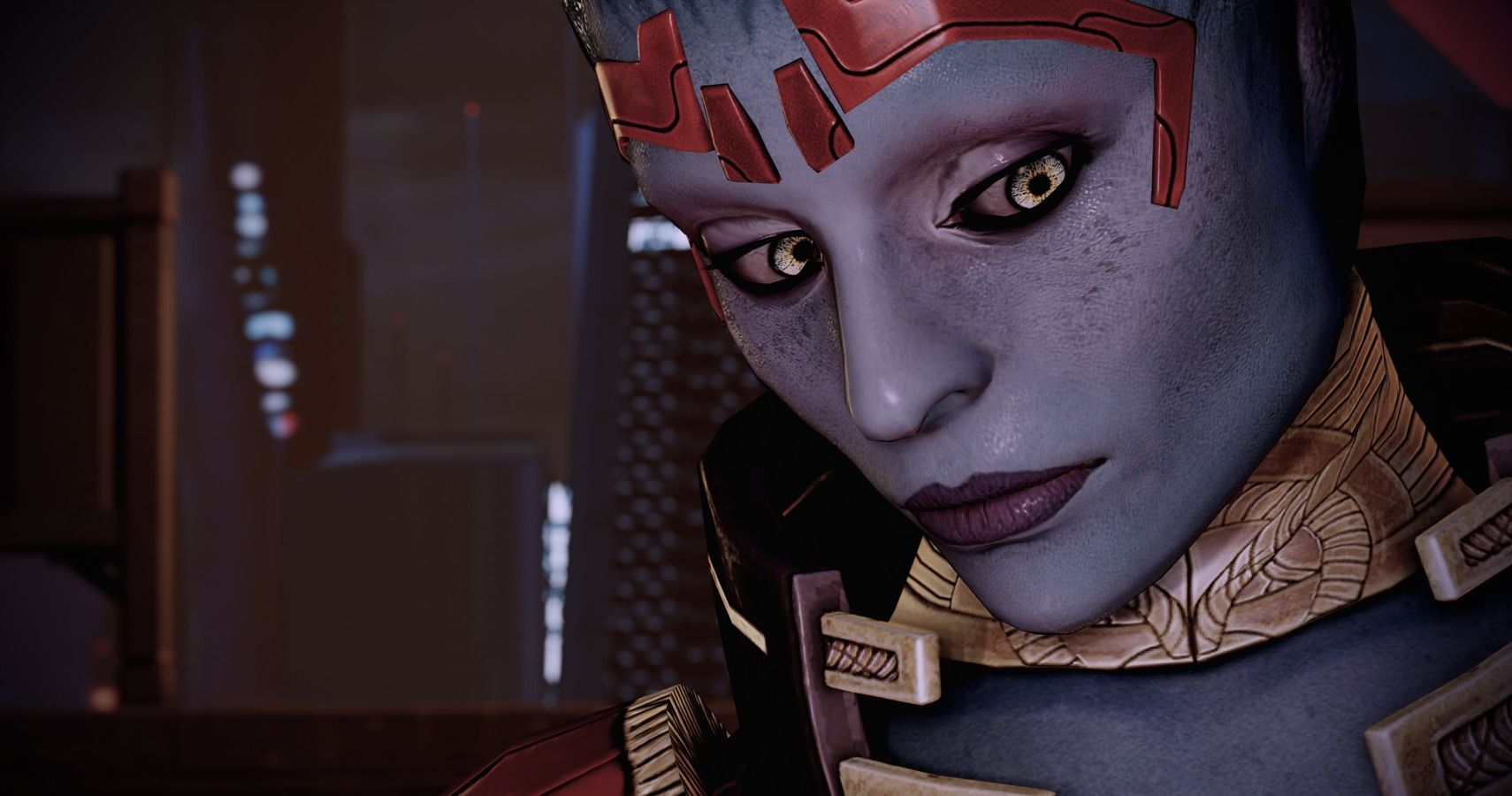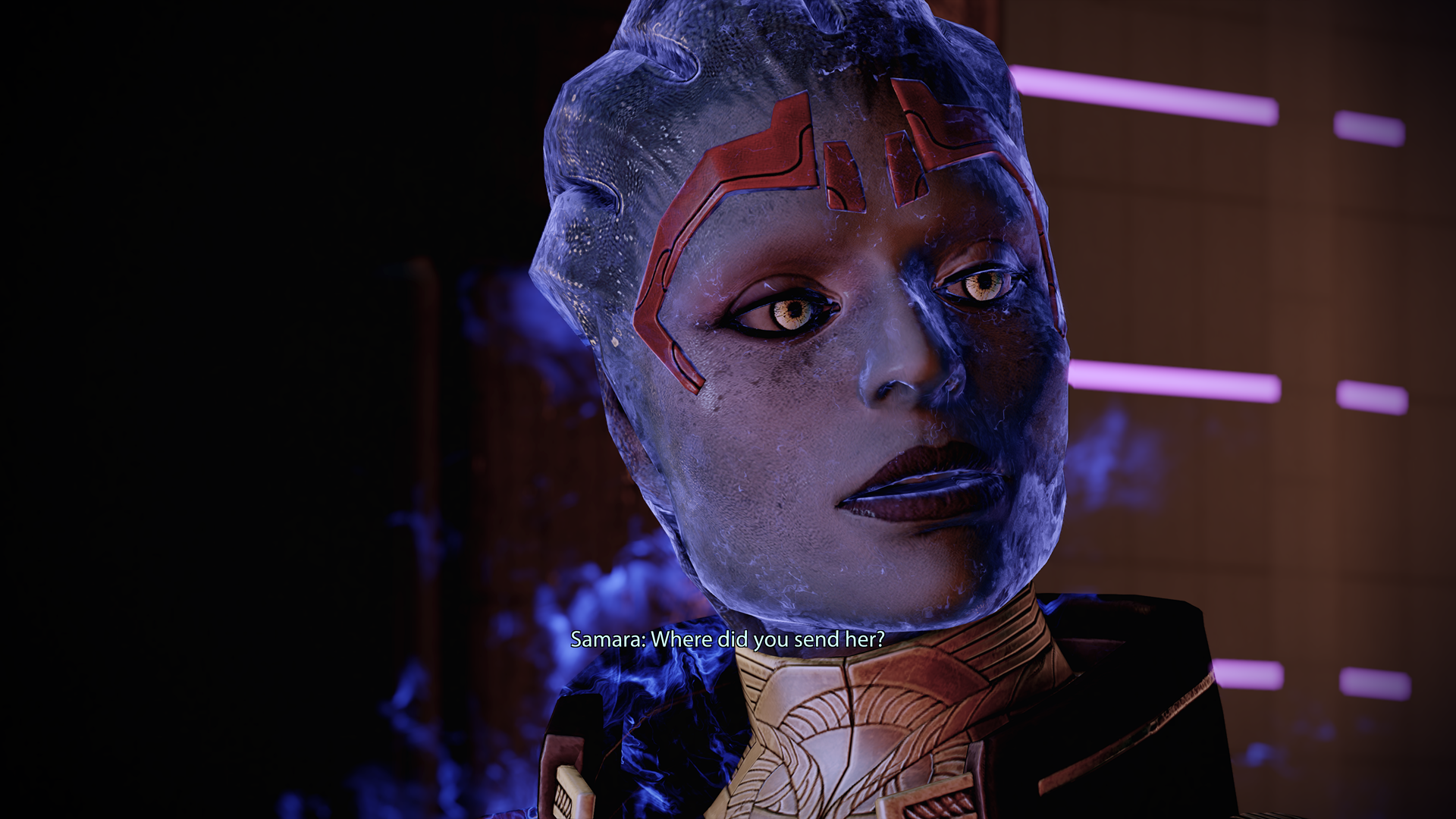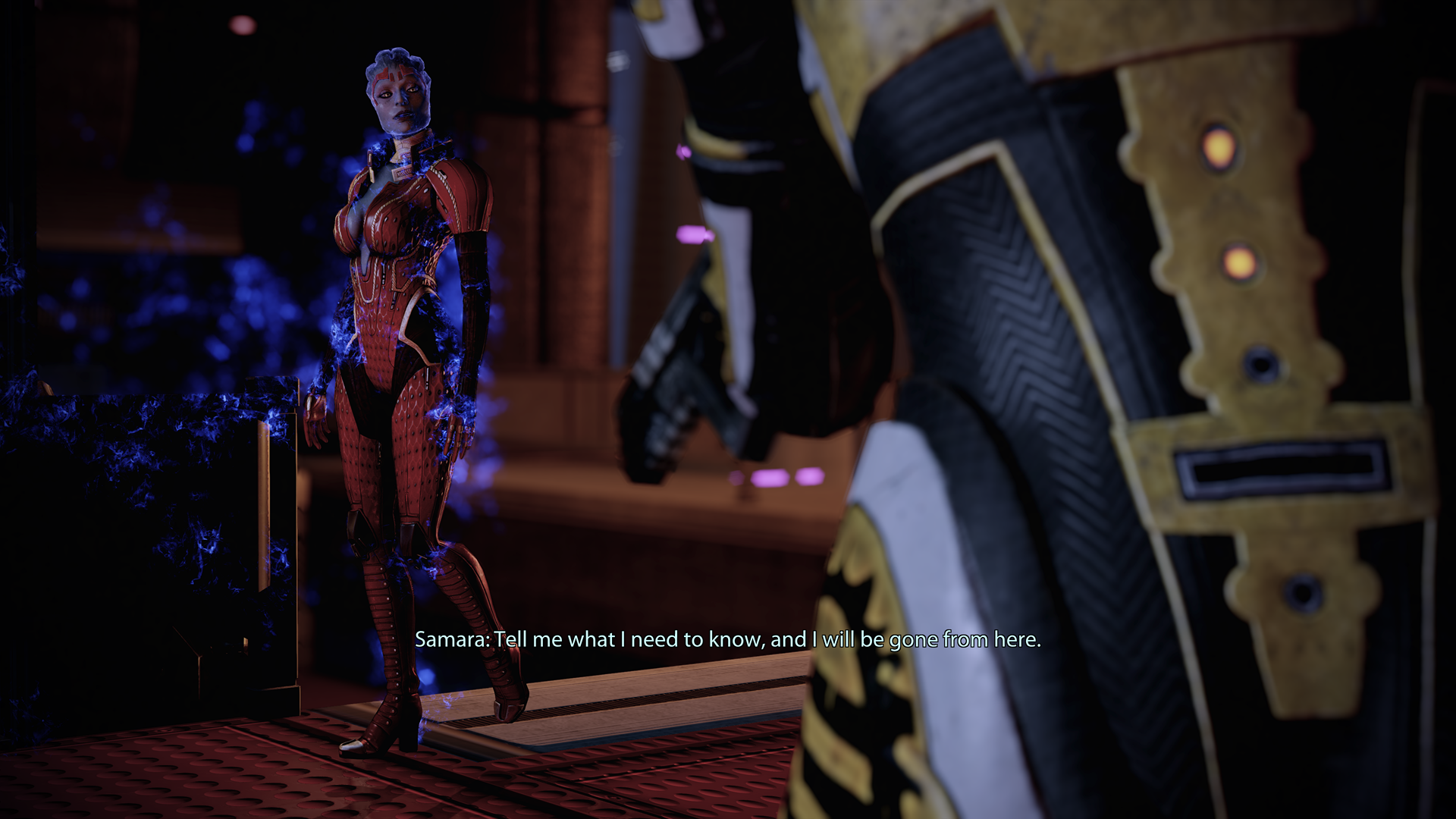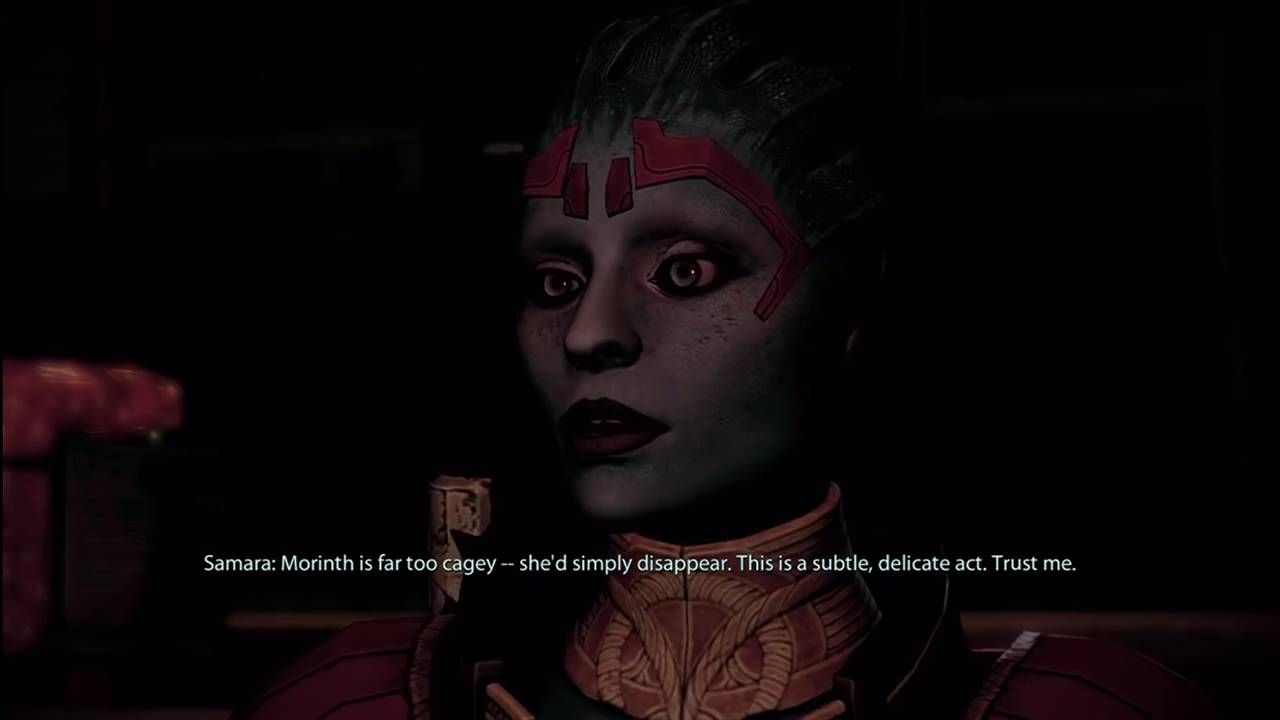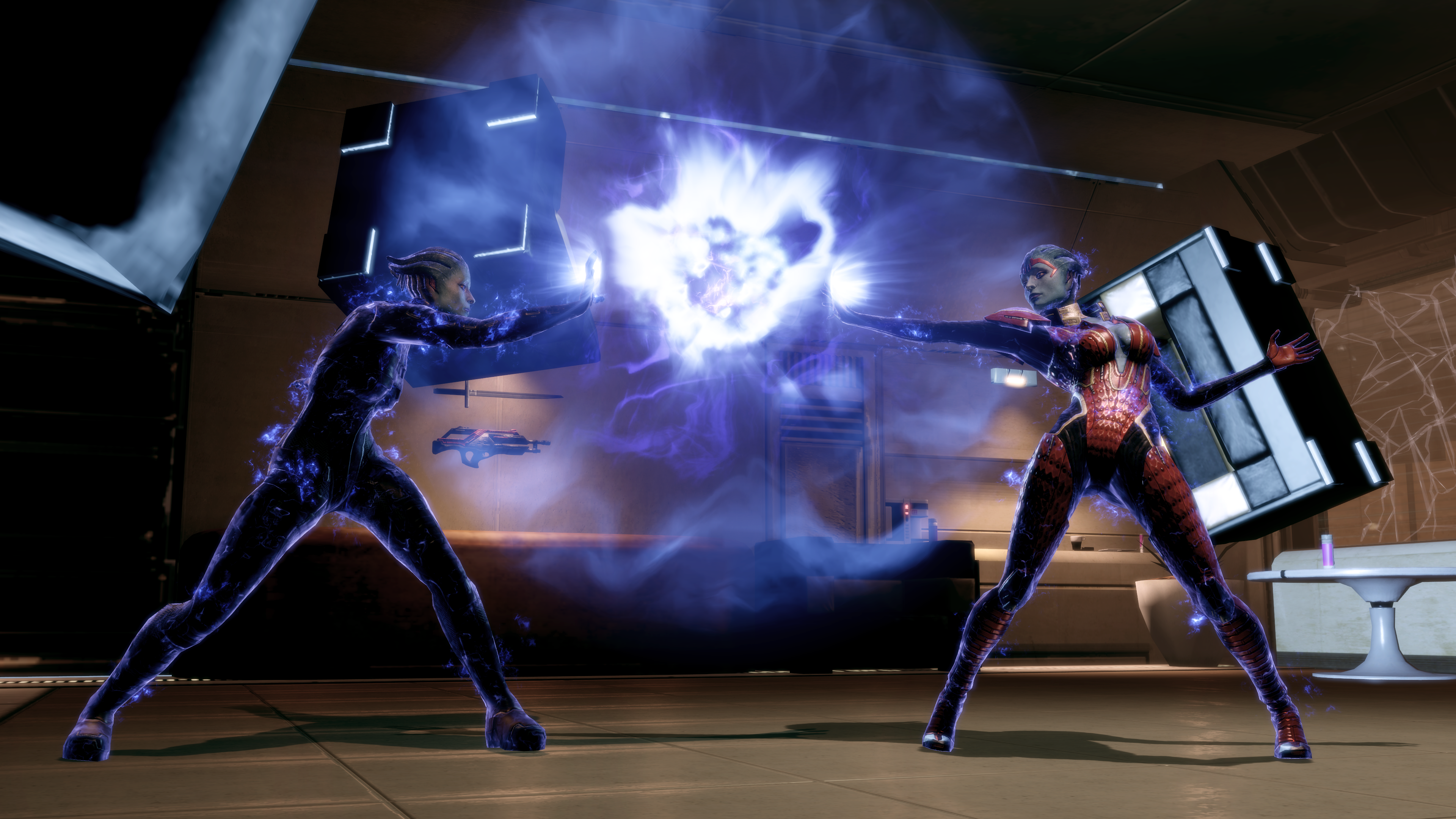“There were definitely concerns,” Mass Effect 2 writer Brian Kindregan tells me. “There were people who were like, ‘I don’t shoot my gun at all?’ Like, no, you don’t. Those are valid concerns - maybe some players don’t want to go to a nightclub and pick up a hot person. In time, really working through the design and keeping it interesting and getting people excited about that concept was, to me, a real success in terms of how a team can move into making a unique and interesting mission. And then the really big challenge for me, personally, was writing the puzzle conversation, where you have to win Morinth over and convince her to take you home.”
For those whose memory of Samara’s loyalty mission in Mass Effect 2 might be a little hazy, it’s one of just two in the entire game that does not require you to use your weapon, the other one being Thane’s. Instead, you’re tasked with heading to Afterlife on Omega, the high-octane, hedonistic nightclub presided over by pirate queen Aria T’Loak. This time around, however, Aria is not the asari you’re looking for - instead, you’re on the hunt for an Ardat-Yakshi named Morinth.
“I read how asari mate, and coming at it from the outside I had a fresh eye,” Kindregan explains, referring to the fact that he didn’t work on the first Mass Effect game and that asari engage in a process called melding with their romantic partners. “Reading it from the outside, I was like ‘oh, well that’s interesting, if you’re blending nervous systems that sounds like a really awesome chance for awful, invasive stuff.’ So I wrote up a thing about Ardat-Yakshi and how that works, and I immediately showed it to Chris [L’Etoile] expecting in the back of my mind that he’d raise objections. He read it and was like ‘yep, that totally fits.’ That was nice right off the bat, because it made it clear it wasn’t that he was trying to claim ownership of the IP, he just wanted it to be coherent. If you came up with a new idea out of the blue that completely fit and was coherent with the existing lore then he was cool - that’s where Ardat-Yakshi came from.”
It’s been a while since Mass Effect 2 originally launched - 11 years, to be precise, which has caused me to crumble into worse disrepair than the original Normandy. If you've forgotten some of the more niche sci-fi terminology, the digestible one-liner on Ardat-Yakshi is that they are asari who kill their partners during sex, after which they become stronger and smarter than they were beforehand. It’s a bit like vampirism except instead of drinking blood you destroy the brains of people you fancy.
This whole concept grew to be at the heart of Samara’s arc in Mass Effect 2, to the extent that her entire narrative reason for becoming an asari Justicar is because three of her daughters are Ardat-Yakshi. While two of them agree to live in a secluded monastery, unable to use their condition as a means of harming other people in the galaxy, Morinth decides to carve out her own lease on life. We see this in Samara’s loyalty mission, although it didn’t always look the way it does in the finished product.
“The lead level designer, Dusty Everman, who is a very strong designer and a strong technical person, but also has a really strong narrative sense - Dusty just got totally on board with the Ardat-Yakshi thing,” Kindregan explains. “We went through some iterations on it. At one point, the very earliest Samara loyalty [mission] was that Morinth had a cult she was leading and some kind of underground thing, and you were trying to break in and she was throwing cultists at you. There were a lot of different versions of it.”
Kindregan explains that he and Everman used to get coffee together every single afternoon during the development of Mass Effect 2. Given that they were based in Edmonton and working through the winter, this meant they were sprinting across ice-licked highways in negative 40 degrees, which Kindregan describes as “fun.” Despite the cold, this gave them lots of opportunities to discuss ifs, buts, and what ifs, which naturally led to the version of Samara’s unique loyalty mission we see in Mass Effect 2 today.
“What was really invaluable was we started to latch onto the idea of Ardat-Yakshi and Morinth in particular as a free spirit,” Kindregan says. “Free spirit is usually used in a very happy way, but [Morinth was] someone who was going to chart her own destiny. Yes, it would hurt other people, but she was not going to live by rules. [She was] someone who was going to tap into the dark underside of sapient or sentient beings. And when you start to get this dark underside, and hedonism, you pretty quickly get to nightclubs and drugs. Not even in a sense of a real commentary on nightclubs and drugs, but what they represent in fiction. You’ve got your Heart of Darkness idea that jungles and wild nature represent the unbridled human impulse and desire, and that nightclubs represent [something] similar - or they can, they can also represent a bunch of club kids with too much money.
“But one version of that is that venue. We quickly got to say, ‘Oh, what if she hunts in nightclubs?’ I love the nightclub scene in Blade, or even in The Matrix, which didn’t involve a predator hunting but where Trinity comes up and starts whispering in Neo's ear. All that feeling of an alternative culture just underneath the surface of one, and one that represents hedonism but also a slightly scary, predatory feel. I’m very proud of that mission, but I definitely think of it as not only the product of many people, but the product of me and Dusty being able to work on it together. Because there was a lot of stuff where, me as a writer - maybe you have to go into the nightclub and shoot it up or something. Because writers at BioWare have to have a very strong technical sense of how the game works, but I didn't necessarily know everything you could do. I thought of the experience narratively, whereas Dusty was able to think of it from a very strong design sense. So Dusty was like, what if you didn’t shoot anything in the club, what if you had to go in and impress someone, not by being too violent but by finding this really careful balance between being cool and violent and all these things. And I was like yes! Can we do that? There’s a thing where if a writer proposes a level like, ‘Yeah, you go in and you talk to people, and you don’t shoot anything,’ everyone’s gonna be like ‘oh well that’s what the writer wants,’ but if the lead level designer proposes that then it’s definitely gonna carry a lot more weight.”
And so Samara’s loyalty mission moved from focusing on Morinth’s cult - which is still referenced in dialogue - and moved to Omega, where you needed to figure out how to get her attention in Afterlife. This is still one of the most distinct missions in the game today, both in terms of design and atmosphere, and displays a kind of ambition and intent that is visible in the DNA of Mass Effect 3’s non-combat set pieces.
“I’ve had a number of people say it’s so much harder than just going in and shooting up a club,” Kindregan says. “It’s very hard to write a puzzle conversation. People have to be able to intuit what the right answer is minus all of the normal feedback we have. When you’re talking to a person in real life you’re picking up on their facial expressions and their body language and all that stuff. That was very tough. That was one where once we hit on the idea that if you did the footwork to find the evidence at the beginning you would have all the right answers as a safety valve. There's many ways to win that conversation without using the evidence you found in the girl’s room. But that was the safety valve, that and the Paragon Renegade [dialogue options]. If you had those you could just brute force your way through the conversation.”
Regardless of how well the mission goes, though, you can only save either Morinth or Samara, and can potentially lose both of them. The puzzle conversation is just one element of what is ultimately one of the longer loyalty missions in the game, which is further complicated by how disparate it feels from the more combat-oriented ones. Interestingly, the end state of the mission also used to be quite different, at least during the concepting phase of development. As opposed to posing as Samara on the Normandy if you take her side during the fight, Morinth had her own unique character model and arc.
“The original design of the Samara loyalty mission was that Morinth had a different face,” Kindregan says. “She couldn't pass for Samara. So if you killed Samara and showed up at the Normandy with Morinth, everybody had some questions. You could lie to them or tell them the truth or whatever. She would go to Samara’s cabin on the Normandy but now you had a new and different party member.”
Kindregan states that she never had the complete arc of the other main characters, only having about two fully fledged conversations, but you were able to talk about her backstory with Samara and what it was like growing up as an Ardat-Yakshi. This was taken out for scope reasons, given that on top of creating a new face and recording different conversations, the team would have had to rework all of the unique interjections that happen during missions for yet another squadmate - it was either make her look like Samara, or leave her out completely, which was why BioWare opted for making them look identical in the end.
Still, the dilemma of who is in the right makes for a compelling narrative core to an even more compelling quest concept, which is something that Kindregan is still proud of to this day.
“For me personally I tried very hard not to have a preferred outcome,” Kindregan explains. “On paper Morinth is a mass serial sex killer, so it’s kinda hard to be on her side. But then again, how many hundreds of people has Samara killed in service to her code. If you kill based on a code - I won't draw the most obvious analogies, but there’s some really bad people in history that have killed hundreds of people because the rules said they should. And honestly the character with the highest body count in the entire Mass Effect universe is Shepard, so...
“The important thing to me is when I’m writing Morinth, I’m trying to write from Morinth’s point of view - ‘Hey look, I was born with this thing, I didn’t ask for it and my society didn’t try to help me with it, their solution was to lock me away and make me waste my entire life and I refused to accept that. So yeah, I have to do some bad things to survive, but I went and I lived my life on my own terms and who the hell are you to judge me?’ That would be Morinth's case for Morinth, and I tried to fully embrace that when writing her. When writing Samara, I tried to fully embrace Samara’s point of view, which is more nuanced because not only is it ‘oh she kills and she’s bad and she was offered a life where she wouldn’t have to do that and she said no,’ but there’s an extra level with Samara which is ‘and in some way this is all my fault, and as brutal as it is i need to redeem myself by killing her.’ Which is a pretty tough thing for any parent to say. So no, I don’t think there’s a right answer. I think the thing I am honestly most proud of in the design of that mission is the fact that if you kill one you talk to the other and you learn they maybe didn’t think of things the way you expected. Morinth is pretty close to what you expected - she basically says that old woman was a hypocrite and it was her fault. But the conversation with Samara after you kill Morinth, you expect her to be like ‘yay, we finally did it and I’m redeemed,’ but instead she’s shattered and she calls Morinth the best and bravest of her children. That, to me, is one of those moments where I really hope it caught people off guard and made them realize there’s a lot more nuance that goes into how characters think than just the surface level stuff.”

